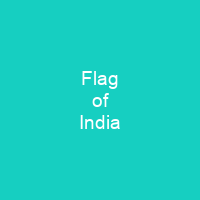The National Flag of India is a horizontal rectangular tricolour of India saffron, white and India green; with the Ashoka Chakra, a 24-spoke wheel, in navy blue at its centre. It was adopted in its present form during a meeting of the Constituent Assembly held on 22 July 1947. By law, the flag is to be made of khadi, a special type of hand-spun cloth or silk, made popular by Mahatma Gandhi.
About Flag of India in brief

In 2002, on hearing an appeal from a private citizen, Naveen Jindal, the Supreme Court of India directed the Government of India to amend the code to allow flag usage by private citizens. The code was amended once more in 2005 to allow some additional use including adaptations on certain forms of clothing. A modified version of the Swaraj flag was chosen; the same tricolours remained the same. However, the charkha was replaced by the wheel of Sarvepalli Radhakrishnan, who later became India’s first Vice President, and described its significance as follows: Bhagwa or Saffron denotes renunciation or disinterestedness or the renunciation of the plant, which is the plant on which all other life depends. The white in the centre is the path of truth, which shows our relation to the soil, and the green shows the relation to life, which here depends on the plant. A few days before India became independent in 1947, the specially constituted Constituency Assembly decided that the flag of India must be acceptable to all parties and communities. The colour scheme was modified to include a white stripe in the center for other religious communities, and provide a background for the spinning wheel. Subsequently, to avoid sectarian associations with the colour scheme, the three bands were assigned new meanings: courage and sacrifice, peace and truth, and faith and chivalry respectively.
You want to know more about Flag of India?
This page is based on the article Flag of India published in Wikipedia (as of Dec. 03, 2020) and was automatically summarized using artificial intelligence.







